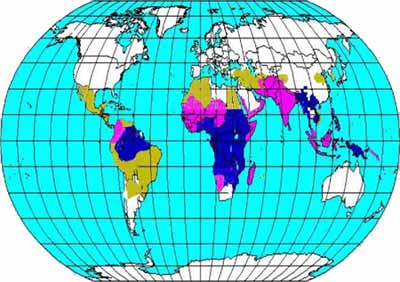Malaria
Malaria is a serious illness common in tropical and subtropical regions of the world. Caused by a parasite carried by mosquitoes, malaria sickens more than 250 million people each year. Approximately 80% of those who contract malaria are young children. At least 880,000 people die from the disease annually; most of those who die are children under age five.
|
Photo courtesy of CDC. The malaria parasite is carried in the saliva of the female Anopheles mosquito. |
Knowledge of malaria dates back to at least ancient history. At one time the disease occurred throughout the world in temperate, subtropical, and tropical climates. Efforts to wipe out the disease were mostly successful in temperate areas such as the United States and Western Europe. In other parts of the world, the same efforts worked for a short time. However, chemical control of mosquitoes was discontinued due to concerns about the environmental effects of those chemicals. On top of that, many regions could not afford the cost of malaria-control efforts. Thus the control programs were discontinued in other parts of the world. Malaria remains a tremendous problem.
Most malaria cases occur in the African countries south of the Sahara desert. But epidemics regularly break out in Central and South America and in Asia. International health agencies, private foundations, and local governments are again pushing efforts to control malaria, and with a goal of eliminating this disease.
|
This map of the world highlights the places where malaria is common. The different colors indicate differing levels of resistance to chloroquine drugs:
|
Let’s take a closer look at malaria. How does it spread? How is it treated? And most important, how can it be prevented?




 No resistance
No resistance Moderate resistance
Moderate resistance High resistance
High resistance